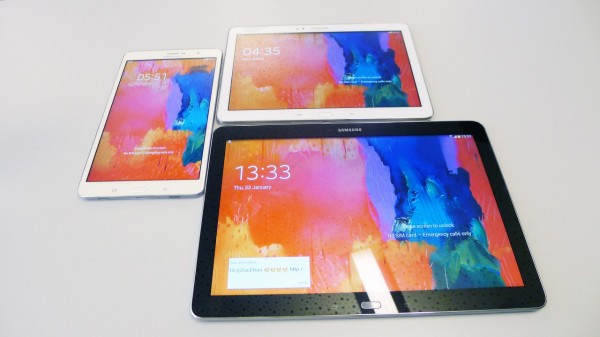
It has seemed like years since Samsung last took the tablet battle seriously, while it concentrated on its smartphones of late.
In the Galaxy NotePro and TabPro, which offer screen sizes of 12.2, 10.1 and 8.4 inches, the Korean electronics maker seems to be finally addressing the high-end market again when these tablets ship in Singapore in the next two months.
The “Pro” in the new Android tablets refers to “progressive” rather than “professional”, according to Samsung. So these tablets are meant to be top-end models for geeks seeking the latest technologies, rather than spartan gadgets for the corporate customer.
The NotePro comes with the S Pen stylus that is seen on other Samsung Note products, while the TabPro doesn’t. For Singapore, the NotePro will come in a large 12.2-inch version, while the TabPro will feature the more common 10.1-inch screen and a new, upsized 8.4-inch model.
All these tablets, unveiled earlier this month in the yearly CES show in the United States, come with a zippy Qualcomm Snapdragon 800 processor for the LTE or 4G version, so you can expect apps to run without much delay.
The Wi-Fi models will feature an eight-core Exynos 5 chip from Samsung itself, according to company representatives who showed the devices to the media today in Singapore.
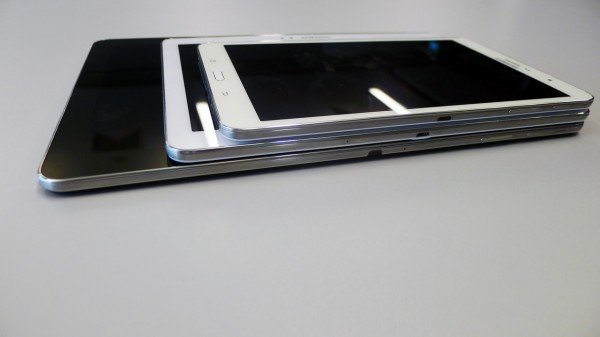
Perhaps more importantly, all three tablets will feature the very high-res 2,560 x 1,600 resolution. This makes things – pictures, text and magazines – extremely sharp. Imagine that amount of detail on a 12.2-inch screen, never mind an 8.4-incher in the TabPro 8.4.
Unlike the smaller TabPros which come with 2GB memory, the top-end NotePro 12.2 has 3GB onboard, which makes apps run smoothly, even if you have four apps tiled up in a multi-window manner.
The onboard 32GB storage for the basic NotePro 12.2 model also trumps the 16GB on the smaller tablets, which Samsung says is aimed more at media consumption than creation.
Still, all three tablets come with some pretty useful tools out of the box. There’s a remote PC app that lets you control what’s on a PC at home or in the office. The Hancom office suite, a powerful alternative to Microsoft Office that offers drag and drop of items in the multi-window view, is included for free as well.
So too is an e-meeting tool that lets you share slides with up to 20 other tablets in a room, as long as you are all logged in to the same Wi-Fi hotspot. So, all the tablets come out of the box with a lot of software that can be instantly useful.
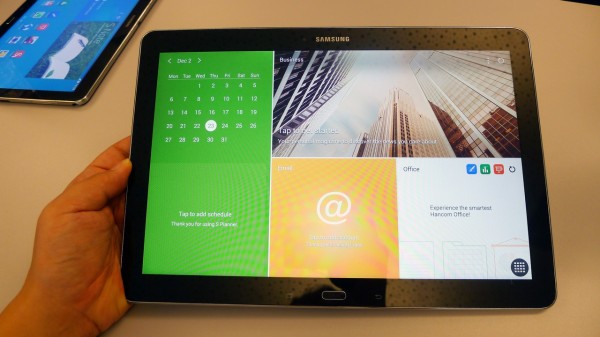
For consumers, the units shown to the media today also came with the New York Times app installed, along with apps from other content providers such as Businessweek. Reading the articles proved a pleasant experience, thanks mainly to the very sharp, high-contrast display.
On the big-screen NotePro 12.2, the text and format on apps certainly didn’t get jumbled up or look too spaced out. That’s probably because the 2,560 x 1,600 resolution is pretty common now, more than a year after the Nexus 10 first debuted.
From the time I spent with the NotePro 12.2 today, I can say I’m impressed by the improvements that Samsung has made in a year.
The design is still typically Samsung Galaxy-like, but the bezel is not thick. Nor is the slim 7.95mm girth, which lets you slip the tablet easily into a bag.
The 12.2-inch screen brings it close to the 13.3-inch laptops that busy executives love. With the productivity apps included, and accessories such as a neat port expander that brings USB and LAN ports to the tablet, the NotePro can be an able alternative to carrying an ultrabook on your travels.
The 9,500mAh battery here is also no slouch. I didn’t have the time to test how long it takes the battery to drain, but going by my experience on my Nexus 10, which features a hefty 9,000mAh battery, this is one tablet that will last a while.
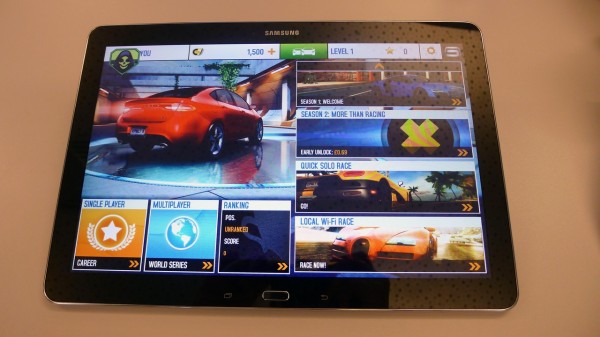
The big screen also makes games a lot more dramatic and playable. Samsung’s Bluetooth controller, which is aimed smaller smartphones, works perfectly with the new tablets as well, as long as you hook it up wirelessly. A driving game certainly plays better with it.
Across the three tablets, I also like the changes Samsung has done to its software interface. In place of the old Touchwiz interface who looks extremely cartoon-like, there’s a new Magazine interface. This lets you customise what you see on the main page through a large tile-like layout.
Not completely original, sure, but it definitely beats the boring icon-driven Touchwiz interface that so many Samsung users have grown to hate.
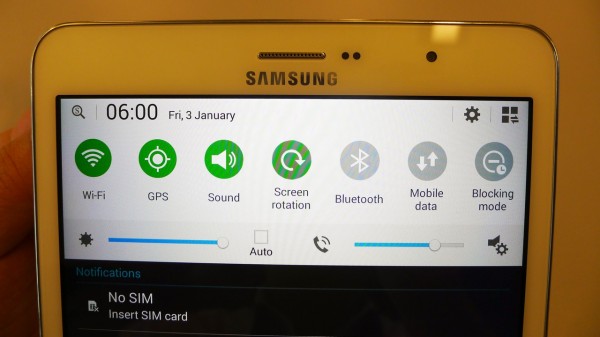
Speaking of which, Touchwiz is still there, but the newer version working on top of Android 4.4 (Kit Kat) is a lot less silly-looking. The icons are still a little too colourful in an often uncoordinated manner, but at least they look flatter like stock Android’s Holo design, which oozes a lot more class.
That’s a huge plus for anyone who has kept away from Samsung because of Touchwiz in the past. And if you like a smaller tablet than the NotePro 12.2, the TabPro 10.1 and 8.4 could be your cup of tea.
In particular, the TabPro 8.4 is nicely positioned as a superior upgrade to Apple’s iPad mini, which offers a 7.9-inch screen. Though it is bigger, the TabPro 8.4 is actually longer and keeps the sides narrow and easily handled with one palm. The display’s 16:10 aspect ratio means your movies don’t get cut off.
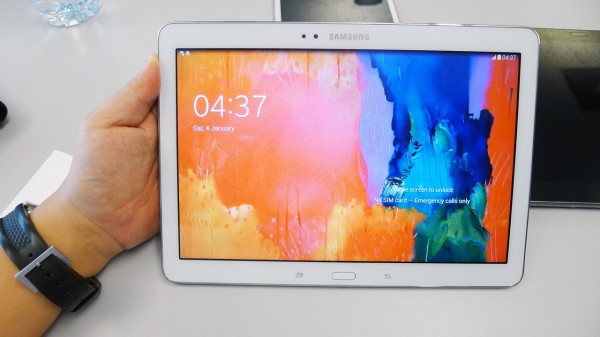
All in, the three new tablets from Samsung come with the familiar feel that the Korean electronics maker has done so well with in the past with all its Galaxy smartphones and tablets. This time round, however, it has also upped the ante with the hardware, in particular, the high-res screens.
Okay, they are not Super AMOLED displays, but for folks who argue that Super LCD offers a less saturated and more natural look, the new tablets will appeal more.
By the way, all three tablets let you make phone calls. You can’t really place the devices next to your ear, even with the smallest 8.4-incher, but with a Bluetooth earpiece, you can call friends on each of them.
Impressive is how I’d describe the new Samsung tablets, after rather ho-hum offerings from the Korean electronics giant of late. For users who have been looking to pick up a high-end Android tablet, the NotePro and TabPro will not disappoint with the hardware they pack and the improved software interface.
Samsung will still sell its existing Galaxy Tabs and Galaxy Notes, though those will be a rung lower in the performance charts than the new Galaxy NotePro and TabPro. It’s about time that the top Android phone maker made a series of solid tablets for Android users.
We’ll have more in-depth tests on a loan unit for review and local prices as they become available.
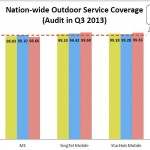





The 12.2″ is intriguing, but other than MS Visio and Java (and Flash), where else would it lose against a full ultrabook?
Hi Ser Wei, I didn’t run enough Powerpoint presentations on the Hancom office productivity software to see if the formatting keeps to its original. Also, while there’s a sort of drag and drop feature – up to four windows – included by Samsung, it’s not as flexible as Windows. One final thing I don’t know yet – the price. If it’s too close to an ultrabook, then it’s tough. Don’t forget you still need a Bluetooth keyboard!